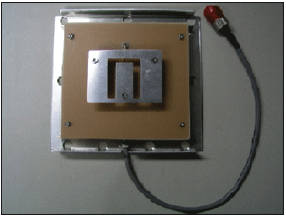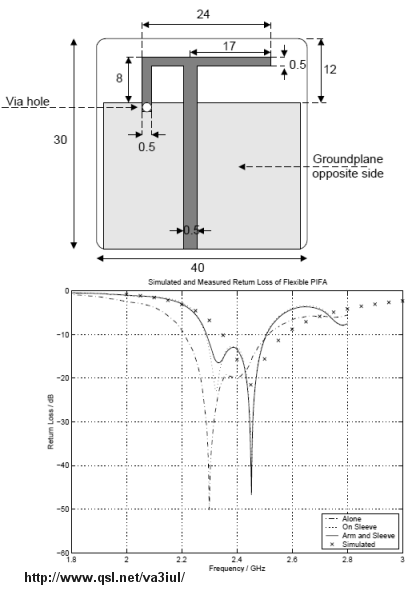U Slot Patch Antenna Design
- Slot Antenna Design
- Design Of U-slot Rectangular Patch Antenna For Wireless Lan At 2.45ghz
- Circular Patch Antenna Design
- Patch Antenna Design
This technique is a modified version of a U-slotted patch antenna. Coupled slots parallel to both ends, arms, of the U-shaped slot are added to enhance the bandwidth. The proposed structure is simulated using IE3DTMand SonnetTM, commercial software packages, and implemented using a foam substrate (εr≈1). Figure 1 shows an example of a wideband antenna with a U-shaped slot for 5-GHz use. The antenna patch is 1.719 in. Long and 0.866 in. With a height of only 3.5 mm, it is designed for low-profile applications, such as in computer WLAN cards. The patch antenna is fed with a probe near the patch. Building the Single U-Slot Patch Define Parameters The basic U-slot patch antenna consists of a rectangular patch radiator within which a U-shaped slot has been cut out. As discussed in, the patch itself is on an air substrate and thick so as to enable higher bandwidths to be achieved. The basic design uses a rectangular U-slot microstrip patch antenna on suitable microwave substrates. The new antenna is a probe-fed rectangular microstrip patch antenna on a permittivity substrate.
Wireless local-area networks (WLANs) at 5 GHz offer the impressive data rates (54 Mb/s) that have helped them grow in popularity. The broad bandwidth of these systems—from 5.15 to 5.85 GHz—also poses a challenge for RF circuit and antenna designers. Fortunately, it is possible to cover the full 5-GHz band using a compact patch antenna.
Traditionally, patch antennas are limited in bandwidth, typically less than 5 percent. But numerous approaches have been developed to increase the bandwidth of a patch antenna, including the use of a U-shaped slot cut into the patch.1,2 A set of design equations has been derived for the purpose of determining the dimensions of the slot relative to the patch size, and these equations have shown good accuracy compared to measured results.2
Figure 1 shows an example of a wideband antenna with a U-shaped slot for 5-GHz use. The antenna patch is 1.719 in. long and 0.866 in. wide. With a height of only 3.5 mm, it is designed for low-profile applications, such as in computer WLAN cards. The patch antenna is fed with a probe near the patch's center. The slot, which is 0.022 in. wide, is cut symmetrically around the RF feed point. The antenna structure is extremely simple, yet offers good RF performance. Figure 2 shows the antenna's return loss, better than 10 dB. The plot shows that the antenna can easily cover a range of 5 to 6.5 GHz with its 26.5-percent bandwidth.
The addition of resonant modes helps to increase patch-antenna bandwidth. Once the multiple resonant points are created, they can be placed at optimized positions for good performance. In the design of Fig. 1, a total of two such resonant points is more than enough to achieve the bandwidth goals for 5-GHz WLAN operation. The total bandwidth and the depth of the combined resonance can be controlled by moving each of the two resonant points closer together or further apart. When the resonant points are closer, the bandwidth is smaller and antenna is better matched to 50 Ω. As the resonant points are spread further apart, the bandwidth increases but the antenna is less matched to 50 Ω.
The patch itself provides one resonant point. The U-shaped slot is another resonant point. The U-shaped slot essentially forces current to flow in a different path on the patch. Each path of current flow corresponds to a resonant point. Once the equivalent current-flow path is determined, it can be easily converted back to the resonant frequency based on its length. This is the basic theory behind this type of antenna. Figures 3 and 4 display the current flow at the two resonant points in the patch antenna. At 5.3 GHz, RF current flows up first, then returns to the feed point. At 6.3 GHz, RF current flows down first. Detailed derivation of the design equation is contained in ref. 2 and will not be repeated here. Since the design is an iterative process, it is possible to compile the design equations from ref. 2 into a MathCAD program. For clarity, the notation of that original reference has been followed here,2 with the MathCAD file shown in Fig. 5. All dimensions are in metric units.
The derived equations, developed by observing the RF current-flow paths on a patch antenna, were used as starting points for the U-shaped patch antenna design. Numerous rounds of simulations were performed for optimizing the design. For this optimization purpose, the IE3D three-dimensional (3D) electromagnetic (EM) simulation software from Zeland Software (Fremont, CA) was used in modeling the patch antenna. Each simulation run required about 20 minutes with good accuracy on a standard personal computer (PC).
The U-shaped patch antenna's radiation pattern is shown in Fig. 6, with the directional pattern typical of patch designs. Simulated maximum antenna gain is close to 9.5 dBi. Because of its compact size, generous bandwidth, and high gain, the U-shaped patch antenna is well suited for point-to-point applications in 5-GHz WLAN systems.
ACKNOWLEDGMENT
The author greatly appreciates the technical supports provided by Dr. Jiang-X Zheng of Zeland on IE3D software. IE3D is a trademark of Zeland Software. Mathcad is a registered trademark of MathSoft, Inc.
REFERENCES
- T. Huynh and K.F. Lee, 'Single-layer single-patch wideband microstrip antenna,' Electronics Letters, Vol. 31, No. 16, August 3, 1995.
- R. Bhalla and L. Shafai, 'Resonance behavior of single U-Slot microstrip patch antenna,' Microwave and Optical Technology Letters, Vol. 32, No. 5, March 5, 2002.
The standard rectangular microstrip patch is a narrowband antenna and provides 6-8 dBi Gain with linear polarization. This example based on the work done in [1],[2], models a broadband patch antenna using a slot in the radiator and develops a dual-band and a tri-band variation from it. In the process, the single wide response has been split into multiple narrow band regions catering to specific bands in the WiMAX standard. These patch antennas have been probe-fed.
Building the Single U-Slot Patch

Define Parameters The basic U-slot patch antenna consists of a rectangular patch radiator within which a U-shaped slot has been cut out. As discussed in [1], the patch itself is on an air substrate and thick so as to enable higher bandwidths to be achieved. The presence of the slot structure achieves additional capacitance within the structure which combines with the inductance of the long probe feed to create a double resonance within the band. The geometry parameters based on [2] are defined and shown in a drawing below.
Define radiator shape - Single U-slot
Use the rectangle shape primitives in Antenna Toolbox™ to create the U-slot patch radiator shape. Boolean subtraction operation is used among the shape primitives for this purpose.
Define ground shape
Create the ground plane shape for the antenna. The groundplane in this case is rectangular and 71 mm x 52 mm in size.
Define stack

Use the pcbStack to define the metal and dielectric layers and the feed for the single U-slot patch antenna. The layers are defined top-down. In this case, the top-most layer is a metal layer defined by the U-slot patch shape. The second layer is a dielectric material, air in this case, and the third layer is the metal ground plane.
Calculate and Plot Reflection Coefficient
Mesh the structure by using a maximum edge length which is one-tenth the wavelength at the highest frequency of operation which is 6 GHz for this example. Compute and plot the reflection coefficient for this antenna over the band. The reflection coefficient is plotted with a reference impedance of 50 ohms.
Calculate and plot pattern
Plot the radiation pattern for this antenna at the frequencies of best match in the band.
Dual-band U-Slot Patch Antenna

Slot Antenna Design
Define Parameters
To achieve dual-band behavior as shown in [1], [2], the double resonance is modified such that the two contributing resonances, i.e. from the patch and from the slot do not merge. To do so the existing slot parameters are adjusted and a second slot is introduced into the structure. The parameters for the double U-slot are listed below as per [2] and a figure annotated with the variables used is shown.
Create Double U-slot radiator
As before use the shape primitives, to create the geometry by using Boolean operations.
Modify Layers in Stack
Modify the existing stack by introducing the new radiator in the Layers property.
Mesh and Plot Reflection Coefficient
Mesh the structure at the highest frequency of operation and calculate the reflection coefficient.
Design Of U-slot Rectangular Patch Antenna For Wireless Lan At 2.45ghz
Triple-Band U-slot Patch Antenna Parameters
For triple-band operation a third U-slot is introduced and the existing slot parameters are adjusted. The parameters are shown below based on [2].
Create Triple U-slot radiator
Modify Layers in Stack
Mesh and Plot Reflection Coefficient
Conclusion
Circular Patch Antenna Design
The models of the multi-band single layer U-slot patch antenna as discussed in [1], and [2] have been built and analyzed and agree well with results reported.
Patch Antenna Design
Reference
[1] K. F. Lee, S. L. S. Yang and A. Kishk, 'The versatile U-slot patch antenna,' 2009 3rd European Conference on Antennas and Propagation, Berlin, 2009, pp. 3312-3314.
[2] W. C. Mok, S. H. Wong, K. M. Luk and K. F. Lee, 'Single-Layer Single-Patch Dual-Band and Triple-Band Patch Antennas,' in IEEE Transactions on Antennas and Propagation, vol. 61, no. 8, pp. 4341-4344, Aug. 2013.